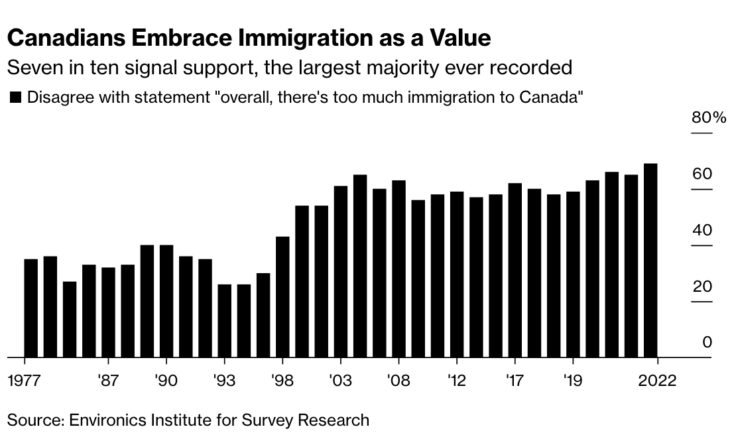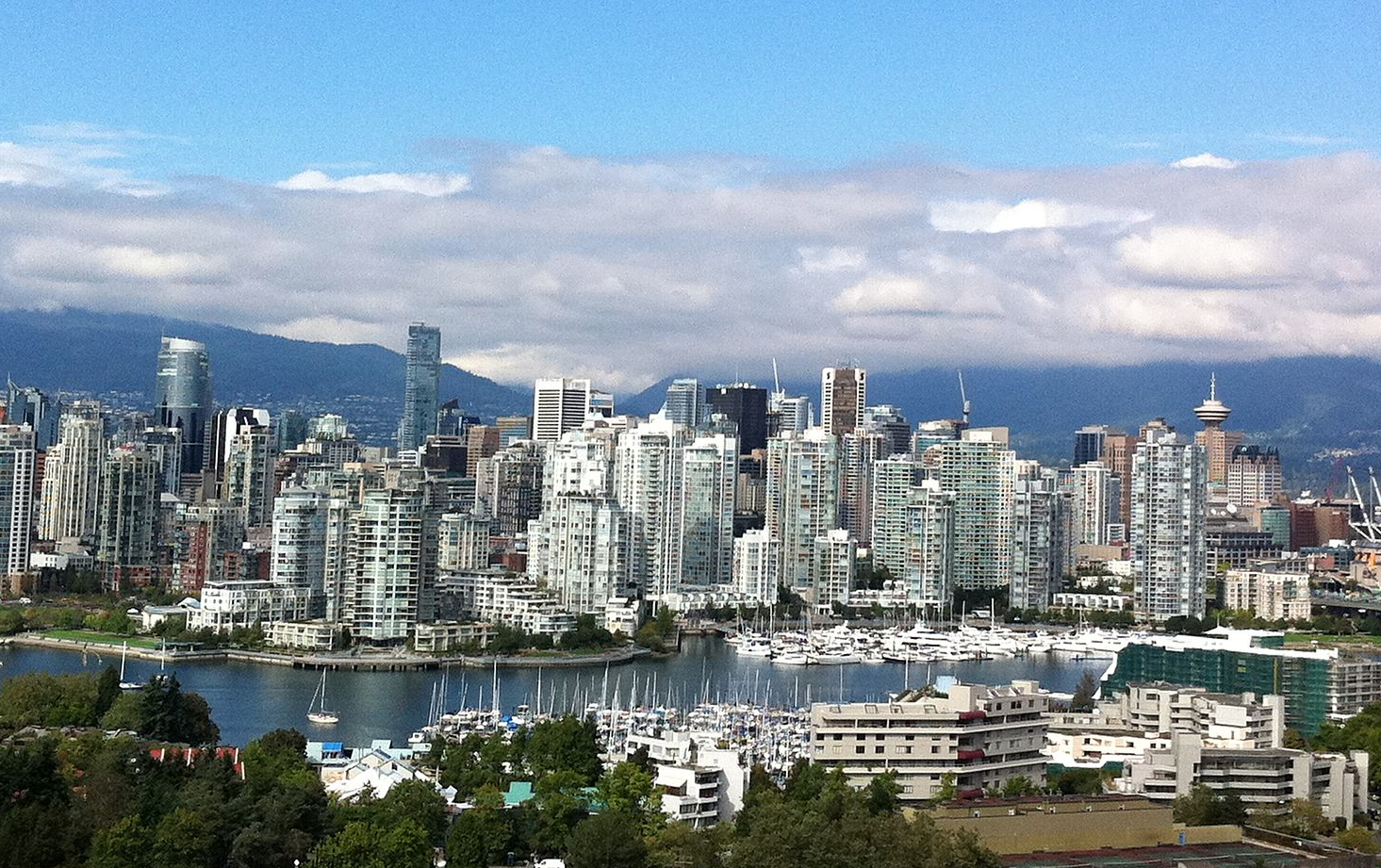Bloomberg has an article on Canadian immigration that raises a number of important issues. Canada is an especially interesting case, as its rate of immigration is now much higher than in the other G-7 nations:
A country about as populous as California has added more than all the residents in San Francisco in a year. Last week, Canada surpassed 40 million people for the first time ever . . .
Nearly one in four people in Canada are now immigrants, the largest proportion among the Group of Seven nations. At the current pace of growth, the smallest G-7 country by population would double its residents in about 26 years, and surpass Italy, France, the UK and Germany by 2050.
The biggest challenge faced by Canada is housing. Like the US, Canada has “NIMBY” policies that make homebuilding very difficult. When combined with high rates of immigration, the result is soaring house prices:
Those type of real estate shocks risk eroding support among Canadians for immigrants, said David Green, a professor at the University of British Columbia’s Vancouver School of Economics.
“We’re opening the door to the same kind of problems that we see in other countries,” Green said. “The hard-right wing is going to pick this up and run with it, and at least a modicum of what they’re going to say on the housing market strains is going to be true. That’s going to give credence to the rest of their narrative. This is a very dangerous game.”
So far, immigration has remained extremely popular in Canada, partly due to the fact that they have avoided the huge waves of illegal immigration seen in the US:

But if the housing problem isn’t fixed, then Canadian public opinion will eventually turn against immigration.
Some libertarians advocate creating a free market paradise in a place beyond the reach of government regulation, such as a “seasteading” platform. Perhaps a better solution would be to convince an indigenous tribe of the virtues of laissez-faire. In Vancouver, indigenous tribes control several pieces of land in booming Vancouver. Normally, this land would be extremely difficult to develop. Some of the sites, however, are not constrained by Vancouver planning rules, and thus the tribes can build whatever they like. As a result, they plan to erect a series of massive developments with dozens of high-rise residential towers.
After many years and steep legal bills, the Musqueam First Nation reached a landmark settlement with the B.C. government in 2008, for the return of some of its traditional territory. Now the Musqueam are using some of those lands near the University of B.C. to provide badly needed housing for the broader community and generate economic prosperity for their Nation. . . .
The Leləm̓ community is just one of several major real estate developments in the pipeline from Vancouver-area First Nations, who have emerged as powerhouse developers in a region desperate for solutions to a housing shortage.
Postmedia analyzed eight major projects involving the Musqueam, Squamish and Tsleil-Waututh Nations, both individually and together under their MST Development Corporation joint venture. Their plans cover nearly 1.1 square kilometres of property in Vancouver, Burnaby and the North Shore, promising more than 25,500 homes.
I find it ironic that in 2023, the only way to observe the true potential of a free market economy is within an Indian reservation.
In a recent interview, California Governor Newsom lamented that his state had lost its ability to build things:
California has become notorious not for what it builds but for what it fails to build. And Newsom knows it. “I watched as a mayor and then a lieutenant governor and now governor as years became decades on high-speed rail,” he said. “People are losing trust and confidence in our ability to build big things. People look at me all the time and ask, ‘What the hell happened to the California of the ’50s and ’60s?’”
(High-speed rail is one of the rare cases where the NIMBYs are correct.)
Perhaps it would be better if California lost a few lawsuits to our Native American tribes, and had to turn over some of our urban land in compensation. It would be doubly ironic if a pro-environment policy of California densification were enacted as a result of YIMBY Native Americans beating NIMBY environmentalists in the political arena.
Update: Commenter BC makes a great point:
Native tribes building high-rise residential towers on their land might be the best example yet of the Coase Theorem. Once clear property rights were liberated from zoning restrictions, the land got allocated to its highest value use, regardless of who owned the property. Of course, the return of the land to the Native tribes does affect wealth distribution.


READER COMMENTS
Brett
Jun 20 2023 at 2:18am
If they can fix their land use policy, they definitely got a lot of land they could do “greenfield” development (even if it’s a bit chilly by US standards). Ontario alone is huge – it’s more than 30% larger than Texas. You could fit another 100 million Canadians in it and still have fewer folks per square mile than Florida.
MarkW
Jun 20 2023 at 7:41am
So far, immigration has remained extremely popular in Canada, partly due to the fact that they have avoided the huge waves of illegal immigration seen in the US
But probably also because Canada uses a ‘points’ system, which strongly favors young, educated workers with job experience and strong English and French skills — no ‘tired, poor, huddled masses’ for Canada. I expect that immigration would be more popular in the U.S. if it used the Canadian system (though, of course, it favors those immigrants who are least likely to be in need of an upgrade).
That said, Canada does have a NIMBY problem, and the First Nations lands ‘hack’ in Vancouver does give me smile. Unfortunately, it’s probably not replicable.
Jon Murphy
Jun 20 2023 at 7:50am
The US does have a system akin to the point system. God knows, we haven’t done the “huddled masses” thing in almost 200 years. The US immigration system is highly geared toward highly intelligent individuals. This is a good summary of the system.
MarkW
Jun 20 2023 at 8:30am
U.S. immigration law is based on the following principles: the reunification of families, admitting immigrants with skills that are valuable to the U.S. economy, protecting refugees, and promoting diversity.
Three of those four categories seem to allow for quite a lot ‘huddle masses’. And I, personally, am fine with that (and high immigration levels generally). But my sense is that Canada puts a lot more weight on ‘immigrants with valuable skills’ than does the US.
TMC
Jun 20 2023 at 8:56am
MarkW, right, only one of those sound like the Canadian system. Add to that the estimated 7 million illegal aliens coming across the southern border in the past 3 years. I’m also for more legal immigration, both higher and low skilled. But when your first act is breaking the law….
Jon Murphy
Jun 20 2023 at 9:01am
But look at the actual levels allowed in legally. Very low. Most emphasis is on high-skilled workers.
MarkW
Jun 20 2023 at 11:53am
But many of the ‘illegal’ US immigrants start out legal. That is, they cross the border, turn themselves in, apply for refugee status, are given a hearing date (all legal so far), and then…don’t show up. Canada doesn’t have this form of quasi-legal refugee immigration because nobody is allowed to present themselves at the US-Canadian border to apply for Canadian refugee status since they’re required to apply in the first country where they’re eligible — namely the US.
BC
Jun 20 2023 at 10:19am
Native tribes building high-rise residential towers on their land might be the best example yet of the Coase Theorem. Once clear property rights were liberated from zoning restrictions, the land got allocated to its highest value use, regardless of who owned the property. Of course, the return of the land to the Native tribes does affect wealth distribution.
Scott Sumner
Jun 20 2023 at 10:34am
Great point!
Rajat
Jun 21 2023 at 6:36pm
Interesting about the indigenous groups collectively using 1.1sq km of land to provide 25,500 homes. However, it does say that most developments are a decade or more away from completion. Melbourne has a 4,800 hectare (4.8 sq km) redevelopment site at the doorstep of the CBD, which is planned to house 80,000 people and provide jobs for another 80,000. However, that will only happen by 2050, 30 years from the plan date. As an observation, that seems very low to me by comparison to the Vancouver situation. For a start, I don’t see why an area 1km from the CBD needs to provide office buildings especially in a post-Covid environment. Second, assuming Vancouver’s new 25,500 homes house, say, ~50,000 people, Melbourne’s Fishermen’s Bend site should really be capable of housing at least 200,000 people.
Anyway, my question is what do you think about the timing of discrete new urban developments like these? If land is made available for (re)development rather than through wider zoning reform (which would promise a flow of new development – ‘competition’ in a sense), then there may be natural incentives stemming from forecast flat prices to develop opportunities quickly to beat alternatives to market. However, where a government only opens up particular sites on an ad hoc basis, do you think it should come with conditions on how quickly the development occurs? Is there a benefit in holding back some new accommodation to smooth its provision over time? I would have thought not, given that the sooner housing is provided, the more total utility it can offer.
Rajat
Jun 21 2023 at 6:38pm
Sorry, I meant that “If land is made available for (re)development rather than through wider zoning reform…, then there may not be natural incentives… to develop opportunities quickly to beat alternatives to market.
Scott Sumner
Jun 22 2023 at 1:09am
I would simply sell the land and let the market decide when to build. Isn’t Hong Kong’s problem that the government holds most of the land and releases it very slowly?
Rajat
Jun 22 2023 at 3:48am
Selling the land raises similar issues, in that it immediately raises the question of to whom should the land be sold? For such a large chunk of prime CBD-edge land, presumably it shouldn’t be all to one owner, even though a single owner may be willing to pay the highest price – in a sense, a monopoly price. My guess is a single owner, would, like the government, drip-feed the land to market. So should a government seller employ antitrust-style principles (eg no buyer gets more than, say, 30%) in deciding to whom to sell?
Scott Sumner
Jun 22 2023 at 12:39pm
It seems unlikely that one buyer would purchase that much land; the cost would be enormous. If I’m wrong, the government could mandate no more than 25% of the land go to any one buyer.
Comments are closed.